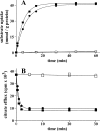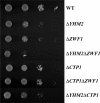Identification and functional characterization of a novel mitochondrial carrier for citrate and oxoglutarate in Saccharomyces cerevisiae
- PMID: 20371607
- PMCID: PMC2878499
- DOI: 10.1074/jbc.M109.097188
Identification and functional characterization of a novel mitochondrial carrier for citrate and oxoglutarate in Saccharomyces cerevisiae
Abstract
Mitochondrial carriers are a family of transport proteins that shuttle metabolites, nucleotides, and coenzymes across the mitochondrial membrane. The function of only a few of the 35 Saccharomyces cerevisiae mitochondrial carriers still remains to be uncovered. In this study, we have functionally defined and characterized the S. cerevisiae mitochondrial carrier Yhm2p. The YHM2 gene was overexpressed in S. cerevisiae, and its product was purified and reconstituted into liposomes. Its transport properties, kinetic parameters, and targeting to mitochondria show that Yhm2p is a mitochondrial transporter for citrate and oxoglutarate. Reconstituted Yhm2p also transported oxaloacetate, succinate, and fumarate to a lesser extent, but virtually not malate and isocitrate. Yhm2p catalyzed only a counter-exchange transport that was saturable and inhibited by sulfhydryl-blocking reagents but not by 1,2,3-benzenetricarboxylate (a powerful inhibitor of the citrate/malate carrier). The physiological role of Yhm2p is to increase the NADPH reducing power in the cytosol (required for biosynthetic and antioxidant reactions) and probably to act as a key component of the citrate-oxoglutarate NADPH redox shuttle between mitochondria and cytosol. This protein function is based on observations documenting a decrease in the NADPH/NADP(+) and GSH/GSSG ratios in the cytosol of DeltaYHM2 cells as well as an increase in the NADPH/NADP(+) ratio in their mitochondria compared with wild-type cells. Our proposal is also supported by the growth defect displayed by the DeltaYHM2 strain and more so by the DeltaYHM2DeltaZWF1 strain upon H(2)O(2) exposure, implying that Yhm2p has an antioxidant function.
Figures












Similar articles
-
Identification of a mitochondrial transporter for pyrimidine nucleotides in Saccharomyces cerevisiae: bacterial expression, reconstitution and functional characterization.Biochem J. 2006 Jan 15;393(Pt 2):441-6. doi: 10.1042/BJ20051284. Biochem J. 2006. PMID: 16194150 Free PMC article.
-
Identification of the mitochondrial NAD+ transporter in Saccharomyces cerevisiae.J Biol Chem. 2006 Jan 20;281(3):1524-31. doi: 10.1074/jbc.M510425200. Epub 2005 Nov 16. J Biol Chem. 2006. PMID: 16291748
-
Mitochondrial citrate transporters Ctp1-Yhm2 and respiratory chain: A coordinated functional connection in Saccharomyces cerevisiae metabolism.Int J Biol Macromol. 2024 Jun;270(Pt 1):132364. doi: 10.1016/j.ijbiomac.2024.132364. Epub 2024 May 13. Int J Biol Macromol. 2024. PMID: 38750837
-
The mitochondrial oxoglutarate carrier: from identification to mechanism.J Bioenerg Biomembr. 2013 Feb;45(1-2):1-13. doi: 10.1007/s10863-012-9475-7. J Bioenerg Biomembr. 2013. PMID: 23054077 Review.
-
Transport of adenine nucleotides in the mitochondria of Saccharomyces cerevisiae: interactions between the ADP/ATP carriers and the ATP-Mg/Pi carrier.Mitochondrion. 2009 Apr;9(2):79-85. doi: 10.1016/j.mito.2009.01.001. Epub 2009 Jan 17. Mitochondrion. 2009. PMID: 19460304 Review.
Cited by
-
Permeability of the peroxisomal membrane: lessons from the glyoxylate cycle.Front Physiol. 2013 Aug 14;4:204. doi: 10.3389/fphys.2013.00204. eCollection 2013. Front Physiol. 2013. PMID: 23966945 Free PMC article.
-
Physiological and pathological roles of mitochondrial SLC25 carriers.Biochem J. 2013 Sep 15;454(3):371-86. doi: 10.1042/BJ20121753. Biochem J. 2013. PMID: 23988125 Free PMC article. Review.
-
Organization and dynamics of yeast mitochondrial nucleoids.Proc Jpn Acad Ser B Phys Biol Sci. 2017;93(5):339-359. doi: 10.2183/pjab.93.021. Proc Jpn Acad Ser B Phys Biol Sci. 2017. PMID: 28496055 Free PMC article. Review.
-
On the role of plant mitochondrial metabolism and its impact on photosynthesis in both optimal and sub-optimal growth conditions.Photosynth Res. 2014 Feb;119(1-2):141-56. doi: 10.1007/s11120-013-9807-4. Epub 2013 Feb 28. Photosynth Res. 2014. PMID: 23456269 Review.
-
Ctp1 and Yhm2: Two Mitochondrial Citrate Transporters to Support Metabolic Flexibility of Saccharomyces cerevisiae.Int J Mol Sci. 2024 Feb 3;25(3):1870. doi: 10.3390/ijms25031870. Int J Mol Sci. 2024. PMID: 38339147 Free PMC article.
References
Publication types
MeSH terms
Substances
LinkOut - more resources
Full Text Sources
Other Literature Sources
Molecular Biology Databases

